Proper tangerine tree care at home
Mandarins are delicious citrus fruits that are rich in vitamins. Recently, they have often been planted in apartments. Caring for a tangerine tree at home is easy, so even inexperienced flower lovers can grow a bush. Delicious tropical fruits are harvested within a couple of years after planting the seeds.
- Variety selection
- Planting and breeding
- Growing from a bone
- Growing from seedlings
- Growing from cuttings
- Mandarin grafting
- Cleavage grafting
- Bark grafting
- Budding
- Tangerine care
- Temperature
- Lighting
- Watering and moisturizing
- Top dressing
- Transplanting and pruning tangerines
- Homemade mandarin diseases
- Diseases caused by microorganisms
- Diseases associated with improper care
- Home tangerine pests
- Summarizing
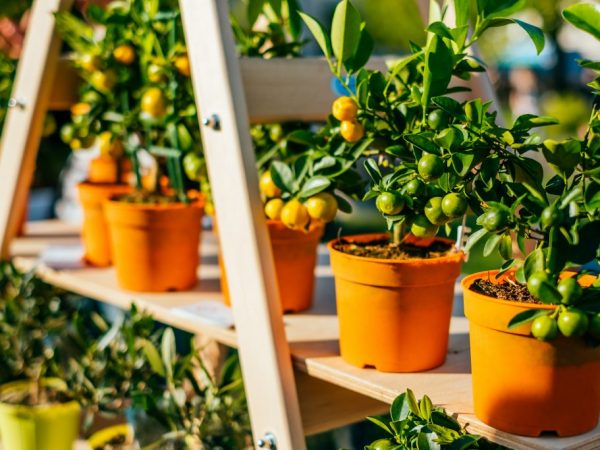
Tangerine tree care at home
Variety selection
The homeland of the mandarin is China. From there, it spread to India, Japan, and other regions of Southeast Asia. The plant belongs to the Rutov family, the genus Citrus. Under natural conditions, it grows up to 3-4 m, the crown has a diameter of 2-3.5 m, the branches are studded with thorns. Trees live in nature for more than 50 years, at home - 10-20 years.
Now dwarf varieties have been bred that are easy to grow at home. The most popular ones are:
- Willow. It is a compact tree with elongated lanceolate leaves. The flower of this tangerine has a diameter of up to 4 cm, the fruits are 6-7 cm.
- Forged-Vasya. A large tree with thick branches, at home grows up to 1 m. Leaves are small, fleshy, fruits up to 6 cm in diameter. The crop is harvested 2 years after planting, with good care, up to 100 tangerines are obtained from the bush.
- Clemnetin. This is the name of a hybrid of a tangerine and an orange, the fruits are small, with a red-orange peel and numerous seeds. Yields a harvest in the second year after planting.
- Pioneer. The fruits are large, weighing 70-90 g. The crown is slightly flattened, compact. Early ripening: early November.
- Unshiu. Japanese dwarf tangerine with thin branches and corrugated leaves. Pitted, pear-shaped fruits. It is really possible to grow such a tangerine at home only from a cuttings.
- Shiva Mikan. Compact small tree with large leaves. Fruits are small, weighing up to 30 g. Ripening time - October or November. Up to 100 mini-fruits are harvested from one tree.
- Honey or Murcott. A small bush with small sweet fruits and a honey flavor. This is where the name of the variety comes from.
- Sochi. A plant with large fruits, weighing more than 80 g. The peel is thin, easy to remove. Mandarins ripen at the very beginning of November.
- Calamondin or citrofortunella. Citrus fruit with green fruits, hybrid with kumquat. Bred in the Philippines. In our climate, fruits ripen if the tree is grown at home or in a greenhouse. The fruit looks unusual, it is tasty and sweet.
When choosing an indoor tangerine, you should look at the yield, the exactingness of the plant for conditions, care. To begin with, they try to plant different varieties in order to choose the most suitable one. You will have to manually pollinate trees when they bloom. Some varieties multiply without this procedure.
Planting and breeding
Citrus fruit is propagated by seeds or seedlings. In the first case, varietal properties are not preserved, so the tree is recommended to be grafted. After planting the seed, you have to wait 3-4 years. But this method allows you to save money. The price of tangerine seedlings is from 100 rubles. and higher.
An alternative breeding option is layering. It does not require material costs and helps to maintain the quality of the variety.
Growing from a bone
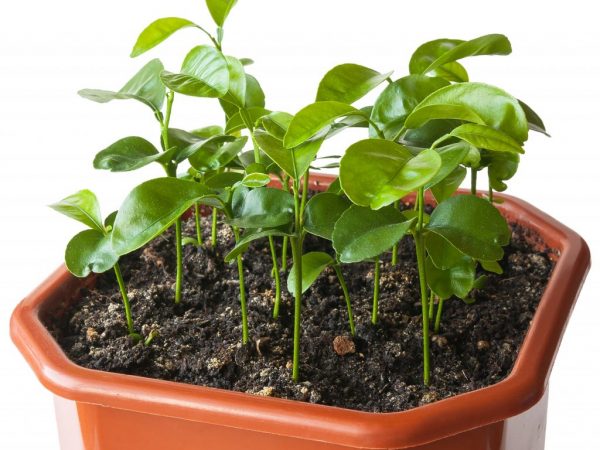
Growing tangerines is not difficult
It is not difficult to grow a tangerine from a bone. The fruits are easy to buy in any supermarket in winter. This is done in December while the citrus fruits are still fresh. The bones are removed from the pulp, washed, put on a saucer and covered with a wet rag. They are placed in a warm place so that the seeds germinate. The rag is constantly moistened. Sometimes a special hydrogel is taken instead of a fabric; it does not need to be watered.
Then the soil is prepared. They buy it in stores (special composition for citrus fruits) or do it yourself. The following soil composition is suitable:
- sheet land - 1 part;
- sod land - 2 parts;
- river sand - 1 part;
- humus - 1 part.
Indoor tangerine does not tolerate acidic soil, therefore peat cannot be added to the mixture. The soil is poured into a pot or container with a volume of 4 liters. Drainage from expanded clay or coarse sand is placed on the bottom. The grain is deepened into the ground by 3-4 cm, the ground is watered. Place in a warm place with a temperature of 20 ° C-22 ° C.
The plant emerges in 2-3 weeks. For reliability, 4-5 seeds are planted in one container, then they are transferred to other pots or pots. The harvest will have to wait a long time, 3-4 years, the bushes are transplanted annually.
Growing from seedlings
Growing cuttings of indoor tangerines is also simple. They buy material in a specialized store or order online. Before buying, they carefully examine the bushes: they should not be stained, moldy. It is advisable to purchase a seedling with leaves and a clod of earth at the roots: it germinates more successfully. If there is an old bush at home, cuttings are cut and placed in water for rooting. After 3-4 weeks, the seedlings are ready for transplanting. The optimal volume of a pot to propagate a tree is 4-5 liters. After planting, the crop is harvested quickly, after 1-2 years.
The tangerine tree is also bought home already grown. This option is suitable for those who have no experience in planting plants. After acquiring a bush in a tub, it remains only to properly care for it: water, spray, fertilize.
Growing from cuttings
Propagation by layers of tangerine is a simple and effective way to root a cutting. Choose a one-year-old twig, about 20 cm long and 4-6 mm thick. With a sharp knife, make 2 circular cuts in the bark, remove it with a ring to force the roots to grow. At a distance of 5 cm above and below the cut, remove all the leaves, pinch the top.
After that, cut a small plastic container in half: take a bottle or an old pot. A twig is placed in it so that the place with the bark removed is in the center. A layer of sand or expanded clay is poured at the bottom, and a nutrient soil (a ready-made mixture or the same composition as for planting seeds) is poured on top.
After 3-4 weeks, the branch gives roots. All this time it is watered, mineral fertilizers are applied twice. When the branch takes root, it remains only to carefully transplant it into a flowerpot with a diameter of 15-20 cm. Reproduction by a shoot is simple, even beginners can do it.
Mandarin grafting
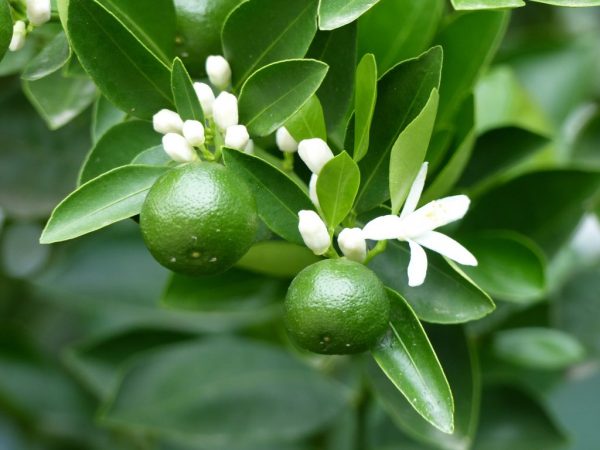
Without vaccination, the fruit will be inedible.
Growing a tangerine at home from a bone is always combined with grafting. Without this procedure, sour, inedible fruits are obtained. It is allowed to graft the plant approximately 2 years after planting. By that time, the stem of the scion has a thickness of about 6 mm. The inoculation is carried out either in the cleft or under the bark. Sometimes grafting is replaced by budding.
With any technique, the following tools are prepared:
- sharp knife;
- scotch tape, electrical tape or a strip of fabric;
- garden var.
Wash hands thoroughly to avoid infection. The procedure is done quickly so that the contact of the slices with air is minimal.
Cleavage grafting
The technique is suitable for beginners and is carried out on mature trunks of 3 years old. A stalk of the selected variety with 2-4 buds is cut obliquely from 2 sides to form a wedge. The length of the slices is approximately 3-4 cm.
Then the trunk is cut in two, the depth of the cleavage is 5 cm. The cutting is inserted so that its cambium comes into contact with the cambium of the scion at least from one side. The trunk is wrapped with tape or cloth, covered with garden pitch. The tree is placed in a greenhouse from a plastic bottle or film until the stalk takes root.
Bark grafting
It takes experience to plant a mandarin plant at home under the bark. This technique is considered more advanced. First, an incision is made in the bark with a length of 3 cm. Carefully separate it from the trunk of the tangerine tree. The stalk is cut obliquely, inserted between the wood and the bark of the stock. They are wound with electrical tape and covered with garden varnish.
In order for the grafting to end successfully, 3-4 cuttings are used at a distance of 2-3 cm from each other. As in the previous case, they build a greenhouse, the tree is regularly watered and mineral fertilizers are applied.
Budding
Planting indoor tangerine at home is easy with a single-bud cuttings. The technique is called "budding". Step by step, it consists of the following stages:
- The trunk of a tangerine tree is wiped with a damp sponge at a height of 10 cm from the ground surface.
- The bud with a piece of wood is separated from the cutting.
- An incision in the shape of the letter T is made on the bark of the rootstock trunk. The height of the cut is 2.5 cm, the width is 1 cm.
- The cut is carefully expanded, a bud with wood is inserted there, and covered with bark on top.
- Wrap with tape and treat with garden varnish, leaving the bud free.
- It is good to put an indoor tangerine in a greenhouse from a plastic bottle or plastic wrap.
The greenhouse is constantly ventilated so that moisture does not stagnate. When the stalk takes root and starts up the first shoots, the trunk of the scion is cut by a third at a distance of 5-10 cm from the grafting. From above, the cut is covered with garden pitch. It is advisable to tie the indoor tangerine tree to a small peg.
Tangerine care
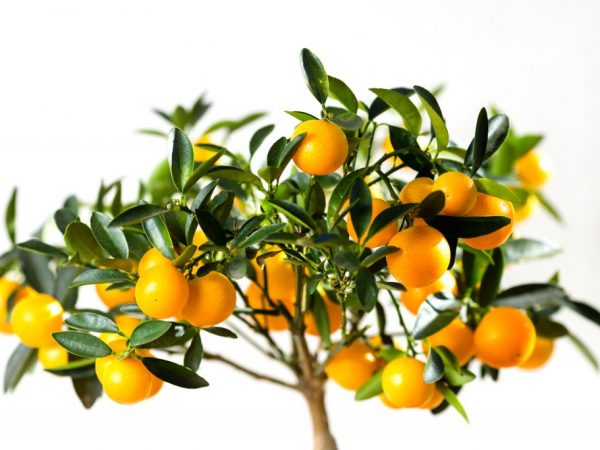
Create good conditions for the plant
Caring for a tangerine at home consists of the usual tricks. It is advised to provide the plant with:
- optimal temperature;
- lighting;
- watering and moisturizing;
- top dressing.
Temperature
In summer, the tangerine tree feels good at temperatures between 20 ° C and 25 ° C. During the day, he is taken out into the open air. If the nights are warm, the bush is left outside. When the temperature drops, it is better to take the tree into the house so that it does not freeze.
In spring, when flowering begins, the temperature is lowered to 18 ° C-20 ° C. If it is higher or lower, the flowers will fall off and the fruits will not be tied. In winter, indoor tangerines are provided with peace. The optimum temperature for him at this time of the year is 5 ° C-10 ° C. At any time of the year, the plant must be protected from drafts and sudden temperature changes.
Lighting
The tangerine tree loves light and is boldly left in the sun. It is good to place the plant on a southern, eastern or southeastern window sill. Direct sunlight is not harmful, but it is still recommended to shade the plant at noon. Lack of light causes a slowdown in growth, the leaves become smaller, take on an unhealthy appearance, and fall off.
Growing tangerine trees in winter has its own characteristics. At this time of year, the day is short, so the plants are provided with additional lighting. A phyto light bulb is used, which is connected to a chandelier or table lamp. The duration of daylight hours is increased gradually so that the tangerine tree does not shed its leaves.
Watering and moisturizing
At home, tangerines should be watered frequently. In the summer, you will need several waterings per day. In winter, this is done 3-4 times a week at a room temperature of 10 ° C-12 ° C.
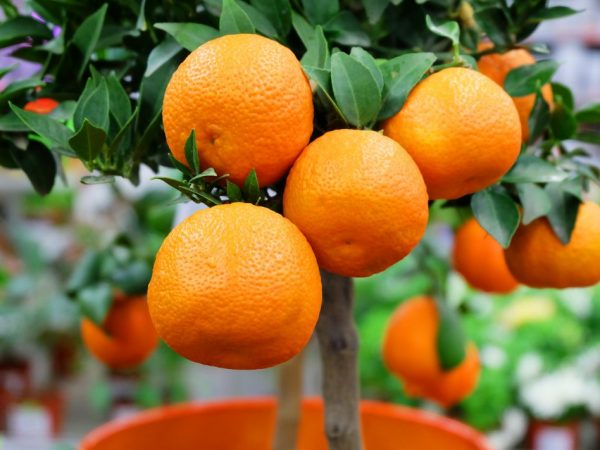
The tree needs to be watered frequently
The following factors affect the volume of water:
- the size of the tangerine tree;
- the size of the pot;
- air temperature;
- the duration of daylight hours and the intensity of illumination.
Watering is controlled by the state of the earthen coma. It should not be too wet, stagnation of water in the pot is unacceptable. Indoor tangerine tolerates drought normally, does not die, but lack of liquid causes leaves to drop.
Mandarin is a moisture-loving houseplant. Water is sprayed at a distance of 5-10 cm from the crown. The procedure is carried out extremely carefully when the tangerine is in bloom. Make sure that the liquid does not get on the flowers. It is recommended to spray from a special sprayer. It is most convenient to keep it on the windowsill.
Top dressing
Growing a healthy tangerine at home is impossible without top dressing. There are few nutrients in the soil of a small box, they need to be added additional. Complex mineral fertilizers containing phosphorus, potassium and nitrogen are suitable. They are liquid and powder. Before feeding, the concentrate is diluted with settled water according to the instructions. Then the tree is watered or sprayed with the concentrate over its crown.
Indoor tangerines begin to feed in early spring, after an increase in daylight hours. This is done every 2 weeks. A minimum amount of fertilizer is applied first. When flowering begins, the amount is gradually increased. Top dressing is finished at the end of September.
Transplanting and pruning tangerines
Transplant a young indoor tangerine annually. From 4-6 years old, the procedure is repeated every 2 years, and after 8 years - every 3 years. The transplant soil is bought in a store or prepared independently. Composition:
- leafy soil - 1 part;
- sod soil - 3 parts;
- humus - 1 part;
- sand - 1 part;
- oily clay - 2-3 tbsp. l.
The volume of the new pot is increased by 100-200 ml. A tangerine transplant at home is carried out carefully so as not to damage the root collar and the roots themselves. The lump of earth is not removed, the indoor tangerine is carefully transferred to a new container with it. After transplanting, the soil is tamped and watered.
It is necessary to form the crown annually, otherwise the tree will grow incorrectly. They begin to pinch the tops in March, when young shoots appear.
Sometimes pruning is done at the end of the growing season. The formation of the crown is done according to the plan, then beautiful ornamental trees are obtained, even with bansai elements. Growing an indoor tangerine is possible even if you do not pinch and trim the tree. But the look of such a bush is not very aesthetic.
Homemade mandarin diseases
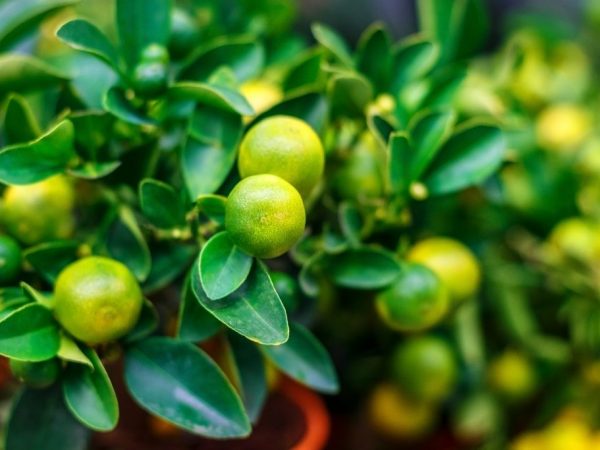
The health of the plant depends on the correct care.
Tangerines, which bear fruit well at home, are susceptible to disease. They are threatened by fungi, bacteria, viruses. Some symptoms are associated with improper care, lack or excess of nutrients in the soil.
Diseases caused by microorganisms
Most often, tangerine at home suffers from fungi, less often it is tempted by bacterial and viral diseases.
Here are the pathologies faced by the owners of a citrus tree:
- Anthracosis. Fungal disease that develops with high humidity, overflow. At first, the plant is covered with light green spots, then it turns black. All organs are affected: leaves, stems, flowers and fruits.
- Wart. This disease is also caused by a fungus. First, transparent specks appear on the leaves, then they thicken and turn into warts. Flowering stops, the ovaries fall off, the bush is no longer able to bear fruit. With a later lesion, orange spots on the fruits form a kind of tuberosity.
- Hommoz. Fungal infection affects the trunk and hilar neck. Over time, it completely destroys the bark, the circulation of juices stops and the plant dies.The disease occurs with a lack of calcium and phosphorus, an excess of nitrogen, overflow, lack of drainage. The reason is often a deep planting of the seedling, damage to the trunk.
- Citrus Cancer. Bacteriosis appears as dark brown spots. If such symptoms appear, the plant cannot be saved and reanimated - it is destroyed.
- Root rot. For a long time, the disease passes imperceptibly, until the plant begins to dry, and the leaves turn yellow and fall off. A fungal infection is indicated by an unpleasant odor, darkening of the lower part of the trunk.
- Tristeza. A viral disease affecting large old trees. The leaves turn yellow and begin to fall off, then the whole bush dries up.
- Xylopsorosis. Another viral pathology characteristic of old plants. The manifestations are similar to gommosis, only the trunk is affected.
- Malsecco. Mandarin is striking at home in the winter-autumn period. It is manifested by a characteristic leaf fall: the plates fall off, and the petioles remain on the branches. Then the shoots begin to dry out until the plant completely dies.
Any fungicide is suitable for combating fungal diseases. Unfortunately, viral and bacterial lesions cannot be treated. To avoid diseases, the bush should be properly fertilized and watered. The optimum room temperature is of great importance.
Diseases associated with improper care
Lack of fertilizer, overflow or underfilling, draft, temperature changes cause the death of the citrus plant. The main symptoms associated with improper care:
- The bush sheds its leaves. This phenomenon is physiological. Leaf fall begins at the end of September and lasts until February. Excessive foliage loss indicates a problem. The reason for this is dry air, planting too deep, lack of potassium in the soil, draft, poor lighting, overflow.
- The leaves turn yellow. The main reason is the lack of nitrogen. In this case, yellowing begins from the bottom until it covers the entire tree. It ceases to bear fruit and dies over time. The symptom is also associated with insufficient watering, then the leaves first turn yellow, then brown, dry at the tips. Sometimes the spider mite becomes the cause of yellowness.
- The leaves are lethargic and dry. If they are covered with a brown crust, there is too much moisture in the pot. When dry leaves appear due to underfilling, they first turn yellow.
Proper tangerine care at home avoids problems. If you know the cause of the symptoms listed above, it is easy to correct the situation. They introduce fertilizers, change the irrigation regime, and the temperature in the room.
Home tangerine pests
Improper care of a dwarf tangerine tree at home makes it defenseless against pests. The reproduction of parasites is facilitated by overdried air, excessive watering. Here are the pests that most often affect the plant:
- shield;
- spider mite;
- greenhouse thrips;
- whitefly;
- mealybug;
- aphid;
- citrus nematode.
Pest detection is easy. Insects most often hide on the lower surface of the leaves. Aphids prefer to occupy leaf stalks, the pest infects plants when they bloom. The spider mite is enveloped in a white film, hence its name. There are difficulties with the citrus nematode: it lives in the ground and harms the roots.
Pests are removed from the branches by hand, sprayed with soap, alcohol or vinegar solution. Spraying with used machine oil and even ordinary vegetable oil helps. Insecticides are used only in extreme cases: they accumulate in fruits and are harmful to health. Spraying such substances is allowed only in a respirator; after the procedure, the room is left for several hours. If a citrus nematode is affected, the bush is recommended to be transplanted.
Summarizing
Growing a homemade tangerine is an interesting and even profitable activity.The plant is not only decorative. Edible and tasty fruits are obtained from it, which ripen in winter, when there is a shortage of fresh fruits. When a tree blooms in spring, it fills the house with an excellent aroma, so planting this tropical bush in your apartment is worth it.


